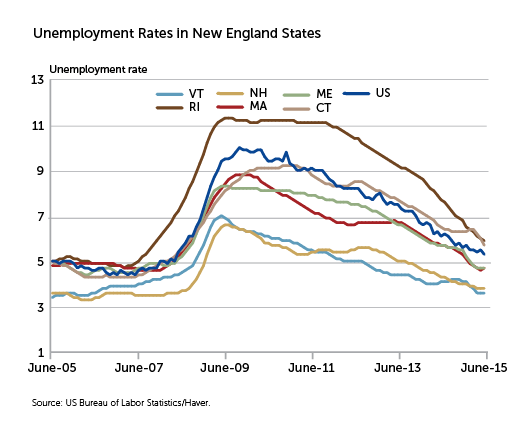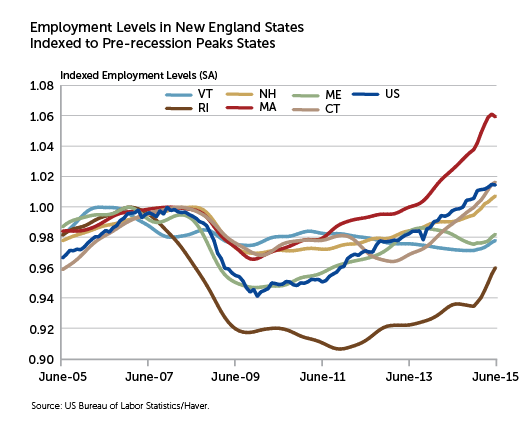Understanding Rhode Island in the Great Recession 
A look at the hard data could sharpen the narrative about the state's slow comeback.
Rhode Island was among the states hit hardest during the Great Recession. Payroll fell 8 percent, the largest decline among the New England states and larger than the nationwide decline of 6 percent. Rhode Island's unemployment rate reached an alarmingly high peak of 11.3 percent in June 2009, and for an extended period (October 2013 to June 2014), the jobless rate was the highest in the nation. (See "Unemployment Rates in New England States.") Although Rhode Island's unemployment rate has since fallen considerably and is no longer the highest in the nation, the state has yet to fully regain the jobs it lost in the recession. As of June 2015, Rhode Island's employment level remained 2.4 percent below its prerecession peak, the largest such jobs deficit in the region. (See "Employment Levels in New England States.")
Can Rhode Island ever expect to regain the jobs it lost in the recession? The answer is both yes and no. Although the state is forecast to get back to its prerecession employment level by 2017, it won't get back all of the same jobs, and the state's labor force may be obliged to adapt to a changing employment landscape.[1]
What Went Wrong
What elements contributed most to Rhode Island's historic job losses, and why has its economy been so slow to recover? Two key factors are to blame: Rhode Island experienced a more pronounced housing boom-and-bust cycle than the other New England states (and even more pronounced than many other states nationwide), and its manufacturing sector was structurally weak before the recession.[2]
During the recession, Rhode Island saw steeper house-price declines than any other New England state and the nation overall. From peak to trough, house prices in Rhode Island fell by about 27 percent, the sixth-largest decline among US states, and above the national average decline of 18 percent.[3]
House-price declines can exert both direct and indirect effects on employment levels. Directly, house-price declines cause job losses in construction and real estate services. Indirectly, when house prices fall, households suffer a loss of wealth and may spend less, which then leads to job losses in other sectors, such as retail.
Separately, the state's manufacturing sector experienced steeper job losses than did manufacturing in any other New England state or the nation overall. Manufacturing accounted for about 10 percent of Rhode Island's payroll jobs prior to the recession and contributed roughly 27 percent of the state's total recession job losses.[4]
Rhode Island's manufacturing job losses contributed to additional job losses in other sectors because of multiplier effects.[5] More important from the standpoint of the state's prospects for recovery, a large share of the lost manufacturing jobs are likely to have been structural, or permanent, job losses, caused in part by forces that were in place well before the recession.
Consider that between 1990 and 2007, the traditional manufacturing industries of the state capital—such as the historically important jewelry industry—faced above-average increases in competition from Chinese imports, compared with the other New England cities and the nation as a whole.[6] (See "Jewelry Manufacturing in Rhode Island.") Global competition was creating job losses before the recession.
However, during the early-to-mid 2000s, the job gains in other sectors generated by the housing boom absorbed many of those displaced workers, leaving the state's overall unemployment rate largely undisturbed and masking the problem.[7] In the Great Recession, the housing bust brought a negative shock to consumer demand, and that accelerated the pace of manufacturing layoffs and destroyed the housing safety net for displaced manufacturing workers.


Hope for the Future
Rhode Island has often been characterized as having the weakest economy in the region. This depiction has been based, first, on the state's unemployment rate remaining roughly tied (along with Connecticut) for highest in New England, and second, on Rhode Island's payroll employment number remaining farther below its prerecession peak level than seen in any other New England state.
Jewelry Manufacturing in Rhode Island
Providence was one of the first cities in the country to industrialize, becoming noted for its manufacturing—particularly its jewelry and silverware industries. By the start of the 20th century, the city boasted some of the largest manufacturing plants in the United States, including Brown , Sharpe, Nicholson File, and Gorham Silverware. From the 1950s to the 1980s, 30 percent of Rhode Island's workforce was employed in manufacturing.[1] During the 1960s, the state was considered a global hub for jewelry manufacturing, and in the 1980s, it produced an estimated 80 percent of costume jewelry made in America.[2]
Nowadays, most jewelry manufacturing has moved overseas. However, a handful of companies continue to make jewelry in Rhode Island, including household names such as Tiffany and Swarovski, and relative newcomer Alex and Ani. Carolyn Rafaelian, founder of Alex and Ani, says that the jewelry her factory produces can't be found in China or anywhere else in the world.
However, the ongoing shortfall in employment compared with peak partly reflects the fact that the state's jobs tally fell farther to begin with. While Rhode Island has experienced a significantly weaker recovery than either Massachusetts or Vermont, its cumulative employment growth rate during the recovery period exceeds that of both Maine and New Hampshire and trails Connecticut's by only a small margin.[8]
To understand Rhode Island's middling recovery, it is tempting to again blame its ailing manufacturing sector, within which employment has barely budged since the depths of the recession. However, during the recovery period, manufacturing employment has also fared poorly in Massachusetts and Vermont, states where total employment now surpasses prerecession levels by a healthy margin. A key factor has been those states' combined education and health services supersector, which has contributed significantly larger employment gains (percentage) than it has in Rhode Island. At the national level, the same supersector has led the economy in terms of total job gains as of this writing.
Although employment growth in Rhode Island's education and health services supersector has lagged that of Massachusetts and Vermont (as well as Connecticut), the state has experienced solid employment growth within both its professional and business-services supersector and its leisure and hospitality supersector, ranking a close second within the region in both cases.[9]
This robust growth in two key service-oriented supersectors represents an encouraging sign for Rhode Island's economic future. Economic research suggests that employment growth, continuing recent trends, will likely favor service-oriented occupations, including both high-skill managerial and so-called "knowledge" jobs as well as low-skilled jobs such as food service. Those trends have arisen because provision of services is harder to outsource than production of manufactured goods, and because both complex intellectual tasks and nonroutine, manual tasks are not easily accomplished by computers or robots.[10]
A key question looking to the future, then, is to what extent Rhode Island's displaced manufacturing workers can find new jobs in service-oriented sectors, and whether such jobs will offer lower wages and reduced benefits or, if not, will require significant retraining.
Mary A. Burke is a senior economist in the Federal Reserve Bank of Boston's research department, where Austin J. Drukker was an intern at the time of this writing. Contact the authors at mary.burke@bos.frb.org.
Endnotes
- "The Road Ahead: Economic Development Challenges and Opportunities for New England" (proceedings, New England Economic Partnership Fall 2014 Economic Outlook Conference, Federal Reserve Bank of Boston, October 2014): 92.
- Mary A. Burke, "Rhode Island in the Great Recession: Factors Contributing to Its Sharp Downturn and Slow Recovery" (report, Federal Reserve Bank of Boston Current Policy Perspectives, September 2014), https://www.bostonfed.org/economic/current-policy-perspectives/2014/cpp1409.htm.
- Federal Housing Finance Authority statistics.
- Bureau of Labor Statistics/Haver Analytics.
- David H. Autor, David Dorn, and Gordon H. Hanson, "The China Syndrome: Local Labor Market Effects of Import Competition in the United States," American Economic Review 103, no. 6 (2013a): 2121—2168.
- David H. Autor, David Dorn, and Gordon H. Hanson, "Untangling Trade and Technology: Evidence from Local Labor Markets" (NBER Working Paper no. 18938, 2013b).
- Kerwin K. Charles, Erik Hurst, and Matthew J. Notowidigdo, "Manufacturing Decline, Housing Booms, and Non-Employment" (NBER working paper no. 18949, 2013).
- This ranking compares the total employment change in each state between the state's employment trough and June 2015, calculated as a percentage of each state's prerecession peak employment level. The ranking is robust to computing the employment change as a share of each state's trough employment level.
- These rankings compare—across states within a given sector—the net employment change in the sector between the state's recession trough date and June 2015, calculated as a percentage of the state's total employment level as of its recession trough date.
- David H. Autor, "How Structural Shifts in Labor Demand Affect Labor Supply Prospects" (in Labor Supply in the New Century, conference proceedings, Federal Reserve Bank of Boston, June 2007): 162—208
Articles may be reprinted if Communities & Banking and the author are credited and the following disclaimer is used: "The views expressed are not necessarily those of the Federal Reserve Bank of Boston or the Federal Reserve System. Information about organizations and upcoming events is strictly informational and not an endorsement."

 About the Authors
About the Authors
Mary A. Burke,
Federal Reserve Bank of Boston
Email: Mary.Burke@bos.frb.org
Austin J. Drukker, Federal Reserve Bank of Boston

 Resources
Resources
Related Content
A New Vision for Workforce Preparation
Race, Ethnicity, and Jobs in Rhode Island
Achieving Greater Fiscal Stability: Guidance for the New England States
Medication-assisted Treatment for Opioid Use Disorder in Rhode Island: Who Gets Treatment, and Does Treatment Improve Health Outcomes?




